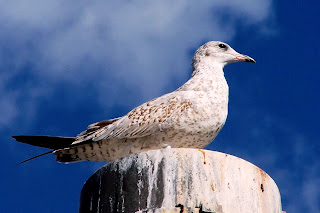The Song Sparrow (Melospiza melodia) is common a year-round resident in my backyard. With its loud and distinctive song, and bold field marks (see below), it is one the easiest species to identify here on the East Coast; and therefore, is one of the first birds that I was able to identify for my life list.
My "typical" Song Sparrow - note its gray and brown head streaks
and broad brown breast streaks and large central spot
Here, in New Jersey our Song Sparrow is the "atlantica" subspecies (below). They are easily attracted to your feeders; and when phished, tend to quickly pop up and will usually sit out in the open providing a good look. If there was any sparrow that I could have said that I felt comfortable identifying, it would have been the Song Sparrow.
M.s. atlantica - Barnegat Light, New Jersey
However, like the Savannah Sparrow, the Song Sparrow also has a number subspecies, and I learned this year that some of the subspecies along the West Coast look very different from the "atlantica" subspecies in my area. Fortunately, was able to photoraph two of these West Coast subspecies.
I saw my first new Song Sparrow subspecies ("kenaiensis") while up in Seward, Alaska this past June. Fortunately, I heard the familiar song of a Song Sparrow first, and then was able to locate the singer - a large, dark sparrow. If I had seen this bird first, my initial impression would have been that it was a dark Fox Sparrow, and not a Song Sparrow. Its was also much shyer and didn't respond to phishing, and therefore, it took me several days before I was able to get a decent photograph (below) of it.
M.s.kenaiensis - Seward, Alaska
I observed a second new subspecies ("morphina") this August, on Washington's Olympic Penninsula. This subspecies is also darker that our "atlantica" but not as big or dark as a "kenaiensis"; and as you can see from the photo below, it was also molting which didn't help. Fortunately for me, it also was readily attraced to a feeder and was not a shy as a "kenaiensis".
M.s.morphina - Sequim, Washington
These two recent encounters with different and distinct looking Song Sparrow sub-species just helped to reinforce my opinion that when I am traveling, I need to try to photograph all of the species I encounter.

.jpg)
.jpg)
.jpg)





+male.jpg)

+Female.jpg)



































